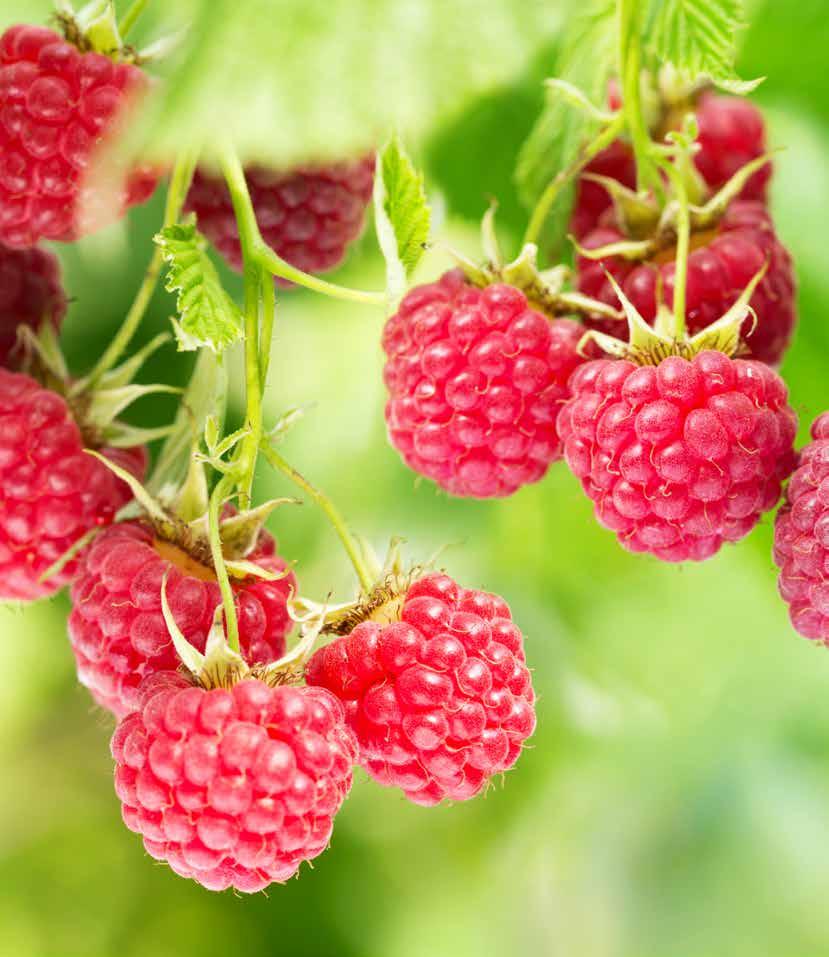

The Wonders of Whatcom
Raspberries, blueberries and strawberries, oh my! Washington state is a leading red raspberry producer in the United States, with over 45 million pounds of raspberries grown in 2021. The vast majority of Washington-grown berries are turned into processed products such as jams, juices and frozen concentrates, but every summer, U-pick berry fields, roadside stands and farmers markets highlight the freshest, locally grown berries. Whatcom County is the epicenter of raspberry growing in Washington, producing 99 percent of all raspberries grown in the state. The county’s amazing berry harvest is a testament to the rich agricultural history and the hardworking growers that make it all possible.
Long before Whatcom County was discovered by Europeans, it was home to Northwest Coast Peoples—the Lummi, Nooksack and Skagit indigenous tribes. Native people foraged for de-
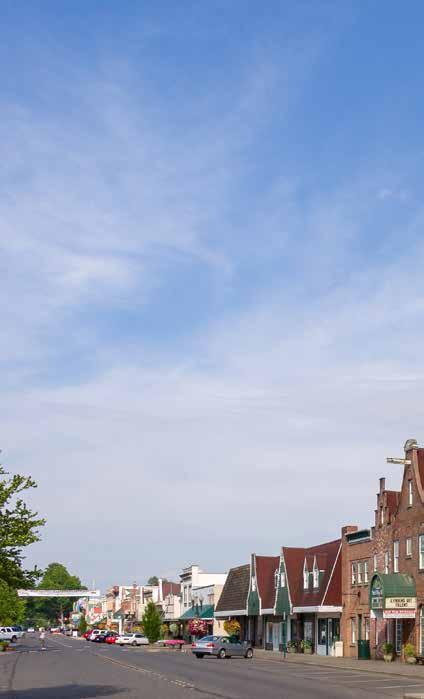
The berry capital of the U.S. is more than just a border community
licious wild berries like salmonberries, huckleberries and trailing blackberries to use as food, medicines, teas and trading goods between tribes. When Europeans arrived, traders and settlers preferred the berries of their homeland: raspberry, blueberry and strawberry.
The first historical evidence for raspberry growing in Washington was in 1833 at Fort Nisqually near Olympia. Chief Trader William Tolmie wrote about “transplanting raspberry bushes from Old Fort into a new garden,” in his Journal of Occurrences. Hudson’s Bay Company, the British trading service, brought the berry seeds and, perhaps, even young berry plants to the West Coast from New England or Europe.
As expansion continued throughout the West, the need for building materials increased. Bellingham Bay had plentiful Douglas fir trees for lumber, and settlers moved north to current-day

Whatcom County. A lumber mill was established in 1854 along an impressive, strategically located waterfall referred to as What-Coom—meaning noisy, rumbling water in the Native language— creating the new, permanent town of the same name. With the arrival of the Northern Pacific Railroad’s western terminus, Bellingham Bay boomed with miners, lumber mills, settlers and, of course, berry farmers.
For the rest of the 1800s, most raspberries were grown on small farms owned by European settlers and sold right from the source. Strawberries and blueberries were also popular crops and often led to experimentation, creating more delectable and sought-after varieties through the turn of the 20th century. Small-scale farms and gar-
den plots gave way to commercial market farms into the 1950s, establishing Whatcom County and Puget Sound as a berry-grower’s paradise.
Throughout the next few decades, blueberries, strawberries and blackberries became widely available in the state, and red raspberries finally took center stage in the 1980s. In the Pacific Northwest, berry tourism has become increasingly popular, including the Northwest Raspberry Festival held in Lynden in Whatcom County every year. Today, many Punjabi Sikh immigrants from British Columbia are prominent raspberry farmers in Whatcom County. The region celebrates a diverse heritage of farmers from Dutch, Punjabi, Canadian and other cultures.

During the first decades of the 21st century and beyond, Washington raspberry farmers have addressed new challenges. Results of climate change like drought, wildfires and heat waves create hazardous working conditions, and in 2021, almost 40 percent of Whatcom County’s raspberry crop was destroyed in a record-breaking heat wave. Disputes over water rights, the use of fertilizers, disease and pests, and labor shortages are all stretching berry farmers thin. Despite all of this, farmers remain positive, and red raspberries from Washington state continue to out-do the competition year after year. When you’re in the area, don’t miss the chance to enjoy the local berries and celebrate the unique experience of this region’s culture!
The Northwest Raspberry Festival
The 33rd annual Northwest Raspberry Festival will be held July 15 & 16 this year. Lynden and the surrounding area are the No. 1 producer of red raspberries in North America, and the festival celebrates the crop and the economic impact it has on this area. The two-day event is attended by roughly 25,000 people who experience 3 on 3 basketball, live entertainment on two stages, street market, kids’ zone, and the Razz and Shine Car Show, to name just a few.
The event features many raspberry delights, including baked goods; fresh raspberries, blueberries and marionberries; pancakes; chocolate; wine; cider; and ice cream. They serve up to 7,500 bowls of the famous, locally made ice cream topped with raspberries during the festival for only $2.

On Saturday of the festival, the Razz and Shine Car Show brings a large number of visitors, and they often have over 300 vintage cars that fill up the tree-lined streets of Lynden.
Don’t miss the festival!
July is the peak time for red raspberry harvest. Don’t miss the summer sunshine and various family-friendly activities at the annual Northwest Raspberry Festival. Join thousands of other fun-seekers and celebrate the berry we know and love!
WHEN: July 15 & 16
WHERE: Downtown Lynden
COST: Free!
Grown With Love

Farm, family, friends
In Lynden and the surrounding areas, they take their berries seriously, and they should. In the cool, marine climate of the Pacific Northwest, Washington produces approximately 90 percent of the nation’s frozen red raspberry crop. Most of that production happens in the northwest corner of the state. We caught up with Jeevan Brar and his family, who have been growing berries in the region since the 1980s. With his family and neighbors, Jeevan makes up part of the strong Punjabi culture of northwest Washington. Working with family and friends is the secret to growing the best berries in the nation.
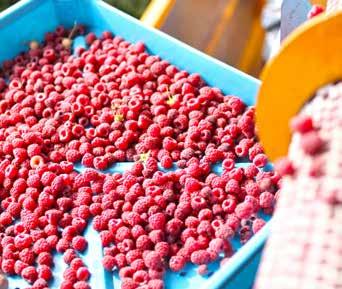


“We are all from one area, and we know each other. We are better than family because we’re all friends, and we all help each other,” explained his father.

“Everyone gets along great,” said Jeevan.
When visiting the area, you can see the Indian culture, the Dutch culture, the Canadian culture, the American culture. “I mean, you can just see it walking down the streets here,” said Washington Grown co-host Val Thomas-Matson.
Along with strong relationships, Washington’s red raspberry growers use technology to bring the best berries to consumers. The new harvesting equipment makes the picking process safer and more efficient. Beaters shake the berries off the plants onto belts that carry the berries up to a platform where debris is removed. Technology like this harvester saves time. Most raspberry farmers also use technology like drip irrigation to save water.
High quality standards make Washington raspberries the best. This starts in the field with the sandy soils and good climate. This high quality continues at the processing plants. Most berries grown in this area are processed. By freezing raspberries within hours of being picked at the peak of ripeness, Washington raspberry producers preserve the fruit’s integrity, flavor and nutritional value, so you can enjoy this delicious and nutritious fruit year-round. Processors like Northwest Berry Co-op use new technology and high safety standards to keep frozen berry products readily available for consumers. They operate a state-of-the-art fruit processing facility located in the heart of Everson.
“The growers will bring the fruits from the field on their trucks, we weigh them in so that we can keep track of them, and we put a tag on every pallet so that we can trace that fruit back to the farm that it came from,” explained Rolf Haugen, the co-op’s manager.
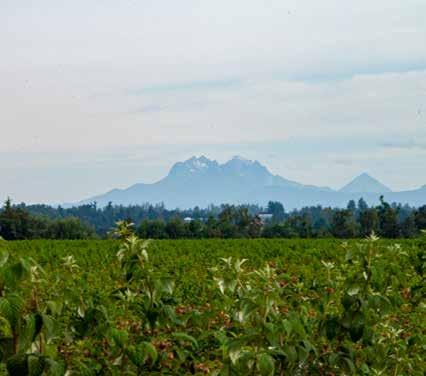
“Actually, in a lot of cases, we can trace it right back to
Why do raspberries have so many seeds?
A single red raspberry (Rubus idaeus) is actually many little fruits or drupelets, all clustered together, each with its own seed. The seeds have the fiber and also may contribute other nutritional benefits such as cardiovascular and brain health, prevention of cancers, especially of the colon. For those who prefer their raspberries without seeds, just press thawed, whole raspberries through a fine sieve or seek out some of the excellent raspberry purees available.

the row. At that point in time, we’ll bring it over here, and we’ll unload it, we test it, and if it passes those tests, then it’ll go on the line to get processed.”

Once the berries hit the line, they are blown off to remove debris, and then they’re washed.
Northwest Berry Co-op is the largest cooperative of raspberry growers in North America.
There are more than 40 different suppliers of red raspberry products in Washington. Next time you enjoy a delicious berry bite, remember all the farms, families and friends who made it possible!
TV & ONLINE

Watch the show online or on your local station

KSPS (Spokane)
Mondays at 7:00 pm and Saturdays at 4:30 pm ksps.org/schedule/
KWSU (Pullman)
Fridays at 6:00 pm nwpb.org/tv-schedules/
KTNW (Richland)
Saturdays at 1:00 pm nwpb.org/tv-schedules


KBTC (Seattle/Tacoma)
Saturdays at 6:30 am and 3:00 pm kbtc.org/tv-schedule/
KIMA (Yakima)/KEPR (Pasco)/KLEW (Lewiston)
Saturdays at 5:00 pm
kimatv.com/station/schedule / keprtv.com/station/schedule klewtv.com/station/schedule
KIRO (Seattle)
Check local listings kiro7.com
NCW Life Channel (Wenatchee)
Check local listings ncwlife.com

RFD-TV
Thursdays at 12:30 pm and Fridays at 9:00 pm (Pacific) rfdtv.com/
*Times/schedules subject to change based upon network schedule. Check station programming to confirm air times.

Lynden Dutch Bakery’s
Raspberry Pie
This beautiful and yummy dessert will leave you wanting another bite!
Filling:
1 pint water
13 ounces sugar
3 ounces pectin
Raspberry flavored gelatin
½ cup water
2 tbsp softened cream cheese
4 pints fresh whole raspberries
½ tablespoon red food coloring (If desired)
Directions:
Bring one pint of water to a boil. In a separate bowl mix 13 ounces sugar, three ounces of pectin and one teaspoon raspberry flavored gelatin with ½ cup water and whisk to dissolve. Add food coloring if desired. Add pectin mix to boiling water and whisk constantly until boiling.
Pie Crust
6 ounces flour
3 ounces margarine
¼ teaspoon salt
Pinch of brown sugar
Pinch of baking powder
1 ounce shortening
1 egg, well beaten
1 ½ teaspoons vinegar
3 tablespoons + 2 ½ teaspoon cold water
Directions:
60 minutes
Grocery List
Pectin Raspberry flavored gelatin
Cream cheese
Raspberries
Brown sugar
Shortening

Pantry ingredients: water, flour, sugar, margarine, egg, baking powder, salt

Vinegar
Add first six ingredients to mixer bowl and mix. Add beaten egg, vinegar and water and mix for five minutes. Roll out into 9” circle and place in pie dish. Bake for 25 minutes at 350°.
Assemble pie as follows:
Spread the softened cream cheese on the bottom of the crust, then layer two pints of fresh whole raspberries. Pour half of the glaze over the top of the berries, then layer on the rest of the fresh whole raspberries on top. Add remaining glaze making sure to seal in all of the berries. Let cool completely. When the pie is cool, edge with whipped cream and add a dollop of whipped cream in the center.
ENTER TO WIN!
Visit our website and sign up to be entered into a drawing for a $25 gift certificate to the Lynden Dutch Bakery in Lynden!

*Limit one entry per household



DID YOU KNOW
Frozen raspberries have six grams of fiber per cup. A one-cup serving of frozen red raspberries provides 28 percent of the daily value of Vitamin C.
BAKERY BELLINGHAM CUPCAKES
FAMILY
FESTIVAL FROZEN IRRIGATION
LYNDEN PROCESSING RASPBERRIES RED
WATER WHATCOM YUMMY
A Lynden Special

The Lynden Dutch Bakery pleases...everyone!
Fresh raspberries from Whatcom County are “simply the best!” according to Chad and Julee Simmons, owners of Lynden Dutch Bakery. “Local berries and dairy are the secret to our success,” including their famous Fresh Raspberry Pie, as seen on Washington Grown. Other mouth-watering treats include Raspberry Delights (puff pastry filled with raspberries, custard and whipped cream); Raspberry Fritters (handmade donut dough blended with berries); the Triple Berry Pie (filled with local raspberries, blueberries and blackberries); and dozens of others. Lynden Dutch Bakery takes fresh berries to a whole new level.
Despite celebrating their 115th anniversary as the second-oldest bakery in Washington state, the bakery finds itself bringing the historic business into the internet age and simultaneously returning to its roots. A recent renovation adjusted the layout to
resemble the original Dutch-style bakery’s floor plan, as well as original brick finishes, intricate tilework, marble countertops, shiplap, and roughhewn wood—almost like walking right into 1907. In addition to a new walk-up service window, Lynden Dutch Bakery now provides online ordering, with many items available for nationwide shipping, including sweet breads, butter cakes, speculaas cookies, gift cards and so much more.
Many of the raspberry goodies offered by Lynden Dutch Bakery are at their best when the berries are freshest —mid-June to mid-July—coinciding with the Northwest Raspberry Festival held in downtown Lynden, attracting nearly 25,000 visitors each year.
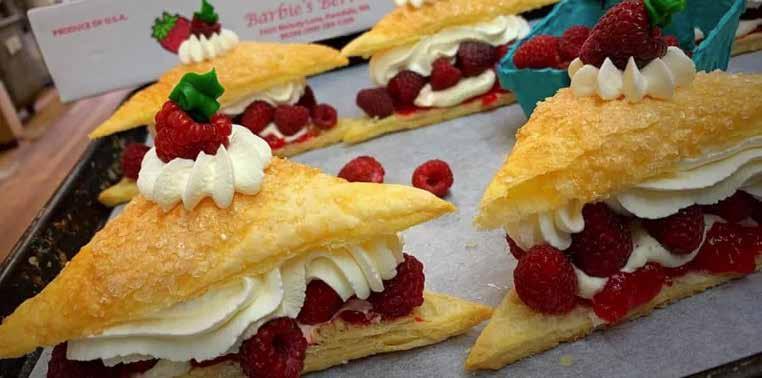
Visit lyndendutchbakery. com for the berry harvest schedule and the best time to order the bakery’s amazing, berry-filled specialities.

Water: timing is everything
Water is essential to all living things, and Lynden gets plenty of it, 40-50 inches of rain per year. The timing of the water — too much in the spring and not enough in the summer — is bringing conservationists and farmers together to solve the problem.
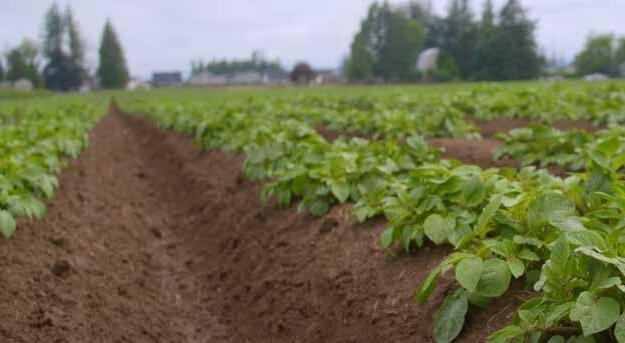
“The issue becomes in the summer months we’re getting less rainfall, and there’s much more demand for the water with crop irrigation, people are outside, more active and using more water, but also, it’s a critical time for salmon,” explained Greg Ebe, a seed potato farmer in Whatcom County. “Salmon are returning to spawn, so there needs to be adequate flow in our streams also for salmon and other wildlife.” The timing of water use is critical in northwest Washington. At times, there is too much water on the landscape and flooding occurs. At other times, such as in the summer, there isn’t enough rainfall, and farmers must irrigate their crops. Many farmers use overhead sprinklers.
Ebe made the transition from overhead sprinklers to drip irrigation a couple of years ago in order to improve his water management system. “We’re probably watering less now than with
some of our overhead methods and maintaining optimum moisture rather than irrigating and having it be too wet and then too dry,” Ebe told Washington Grown co-host Tomás Guzmán.
Like Ebe, other area farmers have used resources from their local conservation districts to improve their water use for their farms and for the salmon.
“Over the last five years, we’ve increased the amount of farmers that are using our programs and services by twentyfold,” said Aneka Sweeney, the education and outreach coordinator for Whatcom Conservation District. “We used to have just a handful of farmers come in, and now we have hundreds a year that are seeing us as a resource, seeing us as a trusted source of information, and recognizing that the research that we do and the farm planning that we do is really vital.”
“A lot’s being done on salmon restoration. We’re planting buffers and developing riparian zones, converting from surface water, which has a direct impact to our streams, to groundwater, moving to more efficient methods of irrigation,”
said Ebe. But there are challenges that prevent others from making the move from overhead to drip irrigation. “Yes. It’s pretty labor-intensive getting it all set up. It is much more expensive cost per acre, but we hope to recover that in yield and quality,” Ebe said.


Another example of how farmers and conservation districts are working together is by applying new technology to old floodgates. “They were exactly that. They were to keep floods out,” explained Sweeney. “They were primarily closed and really prevented any fish passage back and forth. Now, with this new technology, they’re mostly open, and then there’s a float system on it that triggers them to close so that if a flood were to come, it would be protecting that upstream habitat. That is brilliant technology that is really going to be a huge change in the Nooksack River ecosystem.”
“I fully believe that agriculture is the most compatible land use for salmon recovery,” said Ebe.

Our farmlands are a vital part of salmon habitat restoration. As we look to the future, the preservation of large tracks of undeveloped land along our critical creeks, like agriculture, is going to be imperative to the success of our efforts,” said Sweeney.

To learn more about what Washington’s conservation districts are doing and to find one near you, visit scc.wa.govFarmer Greg Ebe of Whatcom County worked with his local conservation district to convert his overhead irrigation to drip on his seed potato fields. This is an effort to reduce overwatering and improve his overall crop.
Find it here!


Rubicon Bakers Vegan Lemon Raspberry Cupcakes launch at Kroger stores near you

You don’t have to go to a farmers market or roadside stand to find locally grown red raspberries. You can find them in nearly every Washington grocery store near you! Did you know Washington state grows 90 percent of the nation’s frozen red raspberries?
A new local treat is hitting stores near you! Rubicon Bakers’ Vegan Lemon Raspberry Cupcakes are now available at Kroger stores, which include Fred Meyer and QFC, through a creative collaboration with Washington red raspberry farmers. The industry partnered with Rubicon Bakers to feature a Washington red raspberry puree in both the filling and icing—the perfect complement to Rubicon’s light and citrusy vegan lemon cupcake.
To celebrate the national availability of this exciting product, Washington red raspberry growers will donate $1 to FareStart for every package
of cupcakes sold, up to $10,000. FareStart is a nonprofit organization based in Seattle that transforms lives, disrupts cycles of poverty, and nourishes communities through food, life skills and job training. FareStart’s work is in line with Rubicon Bakers’ social mission to provide opportunities for those with significant barriers to employment.
“We believe in creating baked goods you can feel good about enjoying, and our Vegan Lemon Raspberry Cupcakes are no exception. The pink color in the icing and filling comes entirely from the vibrant red raspberry puree we source from Washington red raspberry growers,” said Andrew Stoloff and Leslie Crary, co-owners of Rubicon Bakers. “We’re thrilled to see how excited our customers are about this product, and we’re proud to continue working with Washington red raspberry growers!” For more red raspberry information, visit redrazz.org
Val
